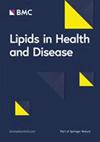The association between triglyceride-glucose index and its combination with systemic inflammation indicators and all-cause and cardiovascular mortality in the general US population: NHANES 1999–2018
IF 3.9
2区 医学
Q2 BIOCHEMISTRY & MOLECULAR BIOLOGY
引用次数: 0
Abstract
The correlation between the triglyceride-glucose (TyG) index and mortality in the general population remains controversial, with inconsistent conclusions emerging from different studies. This study aims to investigate whether there is an association between the TyG index and mortality in the general population in the United States, and to explore whether a new index combining the TyG index with systemic inflammation indicators can better predict all-cause and cardiovascular mortality risks in the general population than using the TyG index alone. Calculate the systemic inflammation indicators and TyG index for each participant based on their complete blood count, as well as their triglyceride and glucose levels in a fasting state. TyG-inflammation indices were obtained by multiplying the TyG index with systemic inflammation indicators (TyG-NLR, TyG-MLR, TyG-lgPLR, TyG-lgSII, and TyG-SIRI). Based on the weighted Cox proportional hazards model, assess whether the TyG and TyG-Inflammation indices are associated with mortality risk in the general population. Restricted cubic splines (RCS) are used to clarify the dose-response relationship between the TyG and TyG-Inflammation indices and mortality, and to visualize the results. Time-dependent receiver operating characteristic (ROC) curves are used to evaluate the accuracy of the TyG and TyG-Inflammation indices in predicting adverse outcomes. This study included 17,118 participants. Over a median follow-up period of 125 months, 2595 patients died. The TyG index was not found to be related to mortality after adjusting for potentially confounding factors. However, the TyG-inflammation indices in the highest quartile (Q4), except for TyG-lgPLR, were significantly associated with both all-cause and cardiovascular mortality, compared to those in the lowest quartile (Q1). Among them, TyG-MLR and TyG-lgSII showed the strongest correlations with all-cause mortality and cardiovascular mortality. Specifically, compared to their respective lowest quartiles (Q1), participants in the highest quartile (Q4) of TyG-MLR had a 48% increased risk of all-cause mortality (95% CI: 1.23–1.77, P for trend < 0.0001), while participants in the highest quartile (Q4) of TyG-lgSII had a 92% increased risk of cardiovascular mortality (95% CI: 1.31–2.81, P for trend < 0.001). Time-dependent ROC curve analysis showed that the TyG-MLR had the highest accuracy in predicting long-term mortality outcomes. The TyG-Inflammation indices constructed based on TyG and systemic inflammation indicators are closely related to mortality in the general population and can better predict the risk of adverse outcomes. However, no association between TyG and mortality in the general population was found.美国普通人群中甘油三酯-葡萄糖指数及其与全身炎症指标的结合与全因死亡率和心血管死亡率之间的关系:1999-2018年全国健康调查
甘油三酯-葡萄糖(TyG)指数与普通人群死亡率之间的相关性仍存在争议,不同研究得出的结论并不一致。本研究旨在调查美国普通人群中TyG指数与死亡率之间是否存在关联,并探讨结合TyG指数和全身炎症指标的新指数是否比单独使用TyG指数能更好地预测普通人群的全因和心血管死亡风险。根据每位参试者的全血细胞计数以及空腹状态下的甘油三酯和葡萄糖水平,计算其全身炎症指标和TyG指数。将 TyG 指数与全身炎症指标(TyG-NLR、TyG-MLR、TyG-lgPLR、TyG-lgSII 和 TyG-SIRI)相乘,得出 TyG-炎症指数。基于加权考克斯比例危险模型,评估TyG和TyG-炎症指数是否与普通人群的死亡风险相关。使用限制性三次样条(RCS)来阐明TyG和TyG-炎症指数与死亡率之间的剂量-反应关系,并使结果可视化。时间依赖性接收器操作特征曲线(ROC)用于评估TyG和TyG-炎症指数预测不良结局的准确性。该研究共纳入 17118 名参与者。在125个月的中位随访期内,2595名患者死亡。在调整了潜在的混杂因素后,发现TyG指数与死亡率无关。然而,与最低四分位数(Q1)的TyG炎症指数相比,最高四分位数(Q4)的TyG炎症指数(TyG-lgPLR除外)与全因死亡率和心血管死亡率均有显著相关性。其中,TyG-MLR 和 TyG-lgSII 与全因死亡率和心血管死亡率的相关性最强。具体而言,与各自的最低四分位数(Q1)相比,TyG-MLR最高四分位数(Q4)的参与者全因死亡风险增加了48%(95% CI:1.23-1.77,P趋势<0.0001),而TyG-lgSII最高四分位数(Q4)的参与者心血管死亡风险增加了92%(95% CI:1.31-2.81,P趋势<0.001)。随时间变化的 ROC 曲线分析表明,TyG-MLR 预测长期死亡率结果的准确性最高。根据TyG和全身炎症指标构建的TyG-炎症指数与普通人群的死亡率密切相关,可以更好地预测不良结局的风险。然而,研究并未发现TyG与普通人群死亡率之间存在关联。
本文章由计算机程序翻译,如有差异,请以英文原文为准。
求助全文
约1分钟内获得全文
求助全文
来源期刊

Lipids in Health and Disease
生物-生化与分子生物学
CiteScore
7.70
自引率
2.20%
发文量
122
审稿时长
3-8 weeks
期刊介绍:
Lipids in Health and Disease is an open access, peer-reviewed, journal that publishes articles on all aspects of lipids: their biochemistry, pharmacology, toxicology, role in health and disease, and the synthesis of new lipid compounds.
Lipids in Health and Disease is aimed at all scientists, health professionals and physicians interested in the area of lipids. Lipids are defined here in their broadest sense, to include: cholesterol, essential fatty acids, saturated fatty acids, phospholipids, inositol lipids, second messenger lipids, enzymes and synthetic machinery that is involved in the metabolism of various lipids in the cells and tissues, and also various aspects of lipid transport, etc. In addition, the journal also publishes research that investigates and defines the role of lipids in various physiological processes, pathology and disease. In particular, the journal aims to bridge the gap between the bench and the clinic by publishing articles that are particularly relevant to human diseases and the role of lipids in the management of various diseases.
 求助内容:
求助内容: 应助结果提醒方式:
应助结果提醒方式:


